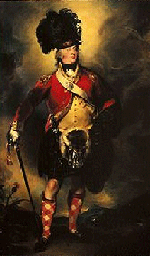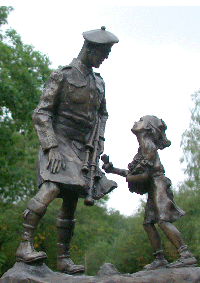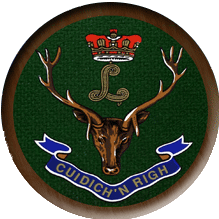History
An Introduction
This is the first part of a three part series on the history of The Seaforth HighlandersOn these pages you can read about the history of our pipe band and of course the regiment of The Seaforth Highlanders of Canada from Vancouver . However, we can’t do so without first telling about where it all started. The origins of The Seaforth Highlanders lies in the land of the clans, lochs, bagpipes and tartans. Scotland!
Scotland: How it all began

1st Baron Seaforth
The first encounter with Dutch soldiers was in 1795 on the island of Ceylon (now Sri Lanka) where the Seaforth Highlanders fought against the Dutch and won. In 1806 the Seaforth from Scotland had another encounter with “Dutch” soldiers in the battles of Cape Town during the Boer War in South Africa.
In 1823 the name of the 72nd Regiment was changed to The Duke of Albany 's Own Highlanders and the regiment moved to South Africa, Gibraltar, Canada and the Caribbean . In 1855 it fought in the Crimean War (Sebastopol ), and from 1858 to 1866 it served in India. Also the regiment was involved in heavy fighting in Afghanistan in 1878.
In July 1881 the 72nd, The Duke of Albany 's Own Highlanders merged with The 78th Highlanders and formed the 1st and 2nd Battalion of the Seaforth Highlanders .
World War I
During the First World War there were eight battalions and one pioneer battalion on duty. The battalions suffered heavy losses among their troops. After the First World War the Seaforth Highlanders went to India, Ireland, Afghanistan, Palestine, Egypt and Shanghai.
Word War II
During World War II, the Seaforth Highlanders played an important role on several fronts . The 2nd, 5th and 6th Battalion fought in the Italy-operation in 1943. The 2nd and 5th Battalion fought in Normandy, while the 1st Battalion was in India.

in Schijndel
Post World War II to Present
After the Second World War, most battalions were disbanded , and the 1st and 2nd Battalion merged. From 1951 to 1954 there was a calm period, when The Seaforth Highlanders stayed in Scotland. Afterwards they went to Egypt, Yemen (Aden) , Gibraltar and Germany (Münster). Finally, the Regiment was merged with The Queens Own Cameron Highlanders as The 1st Battalion Queens Own Highlanders (Seaforth and Camerons). In 1994, a new fusion with The Gordon Highlanders followed up and they became The Highlanders (Seaforth , Gordons and Camerons), and at last (March 2006) they became a part of The Highlanders , 4th Battalion The Royal Regiment of Scotland.
